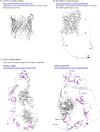Fourteen anti-tick vaccine targets are variably conserved in cattle fever ticks
- PMID: 40234925
- PMCID: PMC12001435
- DOI: 10.1186/s13071-025-06683-5
Fourteen anti-tick vaccine targets are variably conserved in cattle fever ticks
Abstract
Background: Rhipicephalus (Boophilus) microplus causes significant cattle production losses worldwide because it transmits Babesia bovis and B. bigemina, the causative agents of bovine babesiosis. Control of these ticks has primarily relied on treatment of cattle with chemical acaricides, but frequent use, exacerbated by the one-host lifecycle of these ticks, has led to high-level resistance to multiple classes of acaricides. Consequently, new approaches for control, such as anti-tick vaccines, are critically important. Key to this approach is targeting highly conserved antigenic epitopes to reduce the risk of vaccine escape in heterologous tick populations.
Methods: We evaluated amino acid conservation within 14 tick proteins across 167 R. microplus collected from geographically diverse locations in the Americas and Pakistan using polymerase chain reaction (PCR) amplicon sequencing and in silico translation of exons.
Results: We found that amino acid conservation varied considerably across these proteins. Only the voltage-dependent anion channel (VDAC) was fully conserved in all R. microplus samples (protein similarity 1.0). Four other proteins were highly conserved: the aquaporin RmAQP1 (0.989), vitellogenin receptor (0.985), serpin-1 (0.985), and subolesin (0.981). In contrast, the glycoprotein Bm86 was one of the least conserved (0.889). The Bm86 sequence used in the original Australian TickGARD vaccine carried many amino acid replacements compared with the R. microplus populations examined here, supporting the hypothesis that this vaccine target is not optimal for use in the Americas. By mapping amino acid replacements onto predicted three-dimensional (3D) protein models, we also identified amino acid changes within several small-peptide vaccines targeting portions of the aquaporin RmAQP2, chitinase, and Bm86.
Conclusions: These findings emphasize the importance of thoroughly analyzing protein variation within anti-tick vaccine targets across diverse tick populations before selecting candidate vaccine antigens. When considering protein conservation alone, RmAQP1, vitellogenin receptor, serpin-1, subolesin, and especially VDAC rank as high-priority anti-tick vaccine candidates for use in the Americas and perhaps globally.
Keywords: R. annulatus; Rhipicephalus microplus; Anti-tick vaccine; Conserved targets; Surface-exposed epitopes.
© 2025. The Author(s).
Conflict of interest statement
Declarations. Competing interests: The authors declare no competing interests. Ethics approval and consent to participate: The animal study was reviewed and approved by the Institutional Animal Care and Use Committee of the USDA-ARS-CFTRL in Edinburg, Texas (SOP Rearing 1-Host Ticks on Cattle - CFTRL; reviewed 02 February 2021). Consent for publication: Not applicable.
Figures





References
-
- de la Fuente J, Estrada-Pena A, Venzal JM, Kocan KM, Sonenshine DE. Overview: ticks as vectors of pathogens that cause disease in humans and animals. Front Biosci. 2008;13:6938–46. - PubMed
-
- Jongejan F, Uilenberg G. The global importance of ticks. Parasitology. 2004;129:S3-14. - PubMed
-
- Bock R, Jackson L, de Vos A, Jorgensen W. Babesiosis of cattle. Parasitology. 2004;129:S247–69. - PubMed
-
- Bram RA, George JE, Reichard RE, Tabachnick WJ. Threat of foreign arthropod-borne pathogens to livestock in the United States. J Med Entomol. 2002;39:405–16. - PubMed
-
- Guglielmone AA. Epidemiology of babesiosis and anaplasmosis in South and Central America. Vet Parasitol. 1995;57:109–19. - PubMed
MeSH terms
Substances
Grants and funding
LinkOut - more resources
Full Text Sources
Medical

